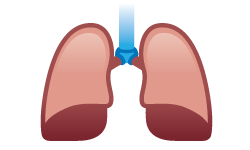Organ-Specific Toxic Effects
Toxic effects that pertain to specific organs and organ systems include:
Toxic effects that pertain to specific organs and organ systems include:
Figure 1. Organ-specific toxic effects pertain to specific organs and organ systems
(Image Source: Adapted from iStock Photos, ©)
(Image Source: Adapted from iStock Photos, ©)
Blood and Cardiovascular/Cardiac Toxicity
|
Blood and Cardiovascular/Cardiac Toxicity results from xenobiotics acting directly on cells in circulating blood, bone marrow, and the heart. Examples of blood and cardiovascular/cardiac toxicity are:
|
Figure 2. Heart cells can be damaged by exposure to certain drugs
(Image Source: Adapted from iStock Photos, ©) |
Dermal Toxicity
|
Dermal Toxicity can occur when a toxicant comes into direct contact with the skin or is distributed to it internally. Effects range from mild irritation to severe changes, such as irreversible damage, hypersensitivity, and skin cancer. Examples of dermal toxicity include:
|
Figure 3. Hand
(Image Source: Adapted from iStock Photos, ©) |
Epigenetic Alterations
|
Epigenetics is an emerging area in toxicology. In the field of genetics, epigenetics involves studying how external or environmental factors can switch genes on and off and change the programming of cells.
More specifically, epigenetics refers to stable changes in the programming of gene expression which can alter the phenotype without changing the DNA sequence (genotype). Epigenetic modifications include DNA methylation, covalent modifications of histone tails, and regulation by non-coding RNAs, among others. Toxicants are examples of factors that can alter genetic programming. |
Figure 4. Chromosome, which contains DNA
(Image Source: Adapted from iStock Photos, ©) |
In the past, toxicology studies have assessed toxicity without measuring its impact at the level where gene expression occurs. Exogenous agents could cause long-term toxicity that continues after the initial exposure has disappeared, and such toxicities remain undetected by current screening methods. Thus, a current challenge in toxicology is to develop screening methods that would detect epigenetic alterations caused by toxicants.
Research is being done to assess epigenetic changes caused by toxicants. For example, the National Institutes of Health (NIH) National Institute of Environmental Health Sciences (NIEHS) Environmental Epigenetics program provides funding for a variety of research projects that use state-of-the-art technologies to analyze epigenetic changes caused by environmental exposures. NIEHS-supported researchers use animals, cell cultures, and human tissue samples to pinpoint how epigenetic changes can lead to harmful health effects and can potentially be passed down to the next generation.
Eye Toxicity
|
Eye Toxicity results from direct contact with or internal distribution to the eye. Because the cornea and conjunctiva are directly exposed to toxicants, conjunctivitis and corneal erosion may be observed following occupational exposure to chemicals. Many household items can cause conjunctivitis. Chemicals in the circulatory system can distribute to the eye and cause corneal opacity, cataracts, and retinal and optic nerve damage. For example:
|
Figure 5. Eye
(Image Source: Adapted from iStock Photos, ©) |
Hepatotoxicity
|
Hepatotoxicity is toxicity to the liver, bile duct, and gall bladder. Because of its extensive blood supply and significant role in metabolism, the liver is particularly susceptible to xenobiotics Thus, it is exposed to high doses of the toxicant or its toxic metabolites. The primary forms of hepatotoxicity are:
|
Figure 6. Liver
(Image Source: Adapted from iStock Photos, ©) |
Related Resource: LiverTox®
The National Library of Medicine LiverTox: Clinical and Research Information on Drug-Induced Liver Injury® has information on liver injury caused by prescription and nonprescription drugs and herbal and dietary supplements, including clinical information on diagnosis and management of drug-induced liver injury and a registry of clinical case reports.
The National Library of Medicine LiverTox: Clinical and Research Information on Drug-Induced Liver Injury® has information on liver injury caused by prescription and nonprescription drugs and herbal and dietary supplements, including clinical information on diagnosis and management of drug-induced liver injury and a registry of clinical case reports.
Immunotoxicity
|
Immunotoxicity is toxicity of the immune system. It can take several forms:
|
Figure 7. Bone (which contains bone marrow) and spleen, both components of the immune system, which recognizes and defends against foreign invaders
(Image Source: Adapted from iStock Photos, ©) |
Nephrotoxicity
|
The kidney is highly susceptible to toxicants because a high volume of blood flows through the organ and it filters large amounts of toxins which can concentrate in the kidney tubules.
Nephrotoxicity is toxicity to the kidneys. It can result in systemic toxicity causing:
|
Figure 8. Kidneys
(Image Source: Adapted from iStock Photos, ©) |
Neurotoxicity
|
Neurotoxicity represents toxicant damage to cells of the central nervous system (brain and spinal cord) and the peripheral nervous system (nerves outside the CNS). The primary types of neurotoxicity are:
|
Figure 9. Brain and synapse are susceptible to toxicant damage
(Image Source: Adapted from iStock Photos, ©) |
Reproductive Toxicity
|
Reproductive Toxicity involves toxicant damage to either the male or female reproductive system. Toxic effects may cause:
|
Figure 10. Female reproductive organs (left); male and female germ cells (right)
(Image Source: Adapted from iStock Photos, ©) |
Respiratory Toxicity
|
Respiratory Toxicity relates to effects on the upper respiratory system (nose, pharynx, larynx, and trachea) and the lower respiratory system (bronchi, bronchioles, and lung alveoli). The primary types of respiratory toxicity are:
|
Figure 11. Lungs
(Image Source: Adapted from iStock Photos, ©) |
Knowledge Check (Solutions on next page)
1) Toxic effects are primarily categorized into two general types:
a) Systemic or organ-specific effects
b) Carcinogenic or teratogenic effects
c) Hepatic or nephrotoxic effects
2) What is the main difference between acute and chronic toxicity?
a) Different organs are involved
b) Acute toxicity occurs only after a single dose, whereas chronic toxicity occurs with multiple doses
c) Acute toxicity appears within hours or days of an exposure, whereas chronic toxicity takes many months or years to become a recognizable clinical disease
d) Acute toxicity is less likely to lead to death than is chronic toxicity
3) Police respond to a 911 call in which two people are found dead in an enclosed bedroom heated by an unvented kerosene stove. There was no sign of trauma or violence. A likely cause of death is:
a) Excess oxygen generated by the combustion of kerosene
b) Acute toxicity due to uncombusted kerosene fumes
c) Acute toxicity due to carbon monoxide poisoning
4) Genetic toxicity can result in:
a) Gene mutation
b) Changes in the structure and/or number of chromosomes
c) Epigenetic alterations
d) All of the above
1) Toxic effects are primarily categorized into two general types:
a) Systemic or organ-specific effects
b) Carcinogenic or teratogenic effects
c) Hepatic or nephrotoxic effects
2) What is the main difference between acute and chronic toxicity?
a) Different organs are involved
b) Acute toxicity occurs only after a single dose, whereas chronic toxicity occurs with multiple doses
c) Acute toxicity appears within hours or days of an exposure, whereas chronic toxicity takes many months or years to become a recognizable clinical disease
d) Acute toxicity is less likely to lead to death than is chronic toxicity
3) Police respond to a 911 call in which two people are found dead in an enclosed bedroom heated by an unvented kerosene stove. There was no sign of trauma or violence. A likely cause of death is:
a) Excess oxygen generated by the combustion of kerosene
b) Acute toxicity due to uncombusted kerosene fumes
c) Acute toxicity due to carbon monoxide poisoning
4) Genetic toxicity can result in:
a) Gene mutation
b) Changes in the structure and/or number of chromosomes
c) Epigenetic alterations
d) All of the above












